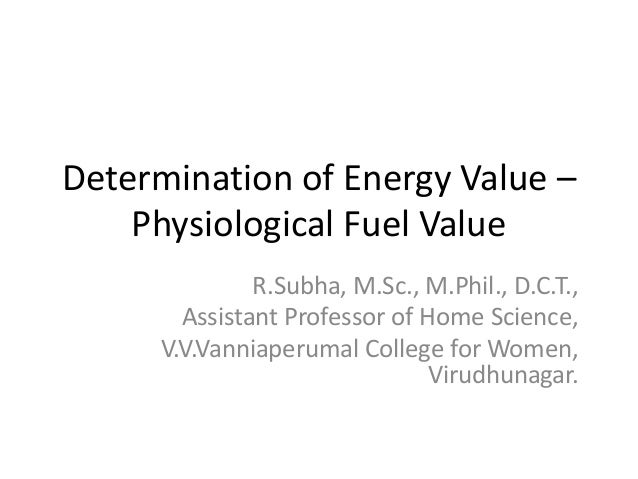
Determination of energy value – physiological fuel value
- 1. Determination of Energy Value – Physiological Fuel Value R.Subha, M.Sc., M.Phil., D.C.T., Assistant Professor of Home Science, V.V.Vanniaperumal College for Women, Virudhunagar.
- 2. JOULES AND CALORIES • The conversion factors for joules and calories are: 1 kJ = 0.239 kcal; and 1 kcal = 4.184 kJ..
- 3. Physiological Fuel • Based on the composition of carbohydrate, fat and protein the heat of combustion of the feed sample can be worked out using appropriate factors. From the gross chemical composition of the feed samples the amount of energy yielding nutrients namely carbohydrate, fat and protein are estimated.
- 4. FLOW OF ENERGY THROUGH THE BODY - A BRIEF OVERVIEW • Ingested energy (IE) or gross energy (GE) Food that is ingested contains energy - the maximum amount being reflected in the heat that is measured after complete combustion to carbon dioxide (CO2) and water in a bomb calorimeter. • Faecal energy (FE) and gaseous energy (GaE) Incomplete digestion of food in the small intestine, in some cases accompanied by fermentation of unabsorbed carbohydrate in the colon, results in losses of energy as faecal energy (FE) and so-called gaseous energy (GaE) in the form of combustible gases (e.g. hydrogen and methane). Short-chain (volatile) fatty acids are also formed in the process, some of which are absorbed and available as energy. • Urinary energy (UE) Most of the energy that is absorbed is available to human metabolism, but some is lost as urinary energy (UE), mainly in the form of nitrogenous waste compounds derived from incomplete catabolism of protein. • Surface energy [SE] A small amount of energy is also lost from the body surface. • Metabolizable energy [ME] The energy that remains after accounting for the important losses is known as “metabolizable energy”. • Dietary-induced thermogenesis (DIT) Not all metabolizable energy is available for the production of ATP. Some energy is utilized during the metabolic processes associated with digestion, absorption and intermediary metabolism of food and can be measured as heat production; this is referred to as dietary-induced thermogenesis (DIT), or thermic effect of food, and varies with the type of food ingested. This can be considered an obligatory energy expenditure and, theoretically, it can be related to the energy factors assigned to foods. • Net Metabolizable Energy (NME) When the energy lost to microbial fermentation and obligatory thermogenesis are subtracted from ME, the result is an expression of the energy content of food, which is referred to as net metabolizable energy (NME).
- 5. • Some energy is also lost as the heat produced by metabolic processes associated with other forms of thermogenesis, such as the effects of cold, hormones, certain drugs, bioactive compounds and stimulants. • In none of these cases is the amount of heat produced dependent on the type of food ingested alone; consequently, these energy losses have generally not been taken into consideration when assigning energy factors to foods. • Net energy (NE) The energy that remains after subtracting these heat losses from NME is referred to as net energy for maintenance (NE), which is the energy that can be used by the human to support basal metabolism, physical activity and the energy needed for growth, pregnancy and lactation.
- 6. Overview of food energy flow through the body for maintenance of energy balance
- 7. • Amount of energy available to the body from a given amount of nutrient is called as Physiological Fuel Value. • Bomb caloriemeter – CHO, Fat and Protein - oxidised completely. • Human body – process of digestion not proceed 100% - efficiency with which nutrient is digested must be taken into account. • Coefficient of digestibility – express the proportion of ingested nutrient which becomes available to the cells of the body.
- 8. Calculation - Physiological Fuel Value/ Atwater Bryant Factors CHO Fat Protein Heat of combustion 4.15 9.45 5.65 Energy from combustion of Nitrogen unavailable to the body - - 1.30 Net heat of combustion 4.15 9.45 4.35 Coeffficient of digestibility 0.98 0.95 0.92 Physiological Fuel Value (Kcal) 4.00 9.00 4.00 Physiological Fuel Value (KJ) 17.00 38.00 17.00
- 10. Reference • Srilakshmi. B, 2018. Nutrition Science, 6th edition. New Age International Pvt Ltd, New Delhi. • https://www.biologydiscussion.com/energy/m etabolism-energy/how-to-measure-calorific- value-of-food/17321